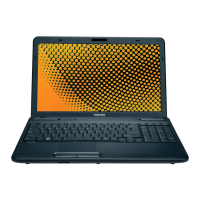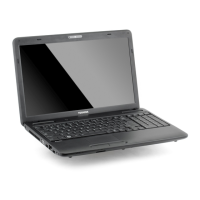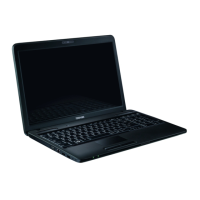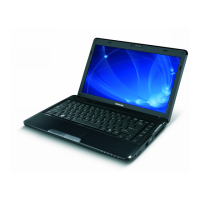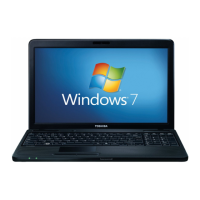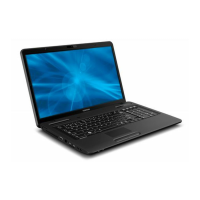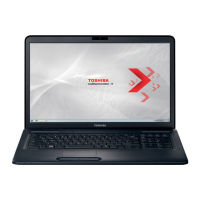
Do you have a question about the Toshiba Satellite C670 Series and is the answer not in the manual?
| Display Size | 17.3 inches |
|---|---|
| Resolution | 1600 x 900 pixels |
| RAM | Up to 8GB DDR3 |
| Storage | Up to 750GB HDD |
| Operating System | Windows 7 Home Premium |
| Optical Drive | DVD SuperMulti Drive |
| Webcam | Yes |
| Battery | 6-cell Lithium-ion |
| Wireless | 802.11b/g/n |
| LAN | 10/100 Ethernet |
| Processor | Intel or AMD (various models) |
| Graphics | Intel HD Graphics |
| Ports | VGA, HDMI, RJ-45, headphone, microphone |
| Weight | 2.8 kg |
Lists included hardware, documentation, and software items.
Provides basic information to start using the computer, including initial setup and power operations.
Explains how to connect the AC adapter for charging and powering the computer.
Describes the procedure to turn on the computer using the power button.
Explains how to properly shut down the computer in different modes (Shut Down, Sleep, Hibernation).
Explains Hibernation Mode, its benefits, and how to enter it.
Introduces the front view of the computer with the display panel closed, detailing indicators.
Describes the ports and components located on the left side of the computer.
Describes the ports and components located on the right side of the computer.
Shows and describes components on the underside of the computer, like battery locks and memory slots.
Illustrates and explains the components visible on the front when the display is open.
Explains the internal hardware components of the computer, such as CPU and Hard Disk Drive.
Explains how to use the Touch Pad and its control buttons for cursor movement and selection.
Introduces the computer's keyboard layout, compatibility, and key types.
Describes how hot key functions enable or disable computer features using FN key combinations.
Describes the optical disc drives, their supported formats, and indicators.
Guides on using software to write data to optical media.
Details limitations and usage notes for the TOSHIBA VIDEO PLAYER software.
Explains limitations and notes on using WinDVD BD for Blu-ray Disc™ playback.
Explains Wireless LAN compatibility, features, and setup.
Discusses built-in Ethernet LAN support and connection procedures.
Explains the memory media slot and its compatibility with various memory cards.
Describes how to install and remove optional memory modules to increase system memory.
Provides step-by-step instructions for installing a new memory module.
Explains how to connect an external analog monitor to the computer.
Describes the HDMI out port and how to connect an HDMI monitor.
Explains how to use a security lock to anchor the computer and prevent theft.
Introduces audio control functions and utilities.
Provides guidance on handling and maintenance of the computer.
Explains the system's heat management features to prevent overheating.
Describes pre-installed utilities and applications, and how to start them.
Explains the Face Recognition utility for logging into Windows.
Provides two levels of password security (User and Supervisor).
Automatically shuts down the system into Sleep or Hibernation Mode after a set duration.
Verifies user face data for logging into Windows, making the process easier.
Allows maintaining security levels with user and supervisor passwords.
Explains how to use the HW Setup program to configure computer settings.
Explains options for recovering and restoring the system.
Discusses battery types, usage, recharging methods, and handling.
Provides important safety precautions for handling and using the battery pack.
Explains how to recharge the battery pack and the role of indicators.
Offers tips to extend the computer's battery operating time.
Explains how to remove and install the battery pack as a consumable item.
Explains the three power-up modes: Shut Down, Hibernation, and Sleep.
Provides guidelines for diagnosing and resolving problems effectively.
Offers easy-to-fix checks for common issues that may appear serious.
Guides on identifying problems by observing system clues and asking key questions.
Provides steps to troubleshoot when the computer fails to power on.
Lists common hardware and peripheral issues that may cause problems.
Addresses issues with the hard disk drive, including booting and slow performance.
Troubleshooting steps for the Touch Pad not working or having sensitivity issues.
Information on how to contact TOSHIBA for additional technical assistance.
Lists operating and non-operating environmental conditions like temperature and humidity.
Details the AC adapter and computer power specifications.
Lists various certification agencies for power cords by country.
Discusses CPU performance variations based on operating conditions and configuration.
Describes how main system memory is used, including graphics and limitations of 32-bit OS.
Explains factors affecting battery life and published numbers.
Details Wireless LAN compatibility and compliance with IEEE standards and Wi-Fi Alliance.
Warns about potential interference and performance issues when using wireless devices.



